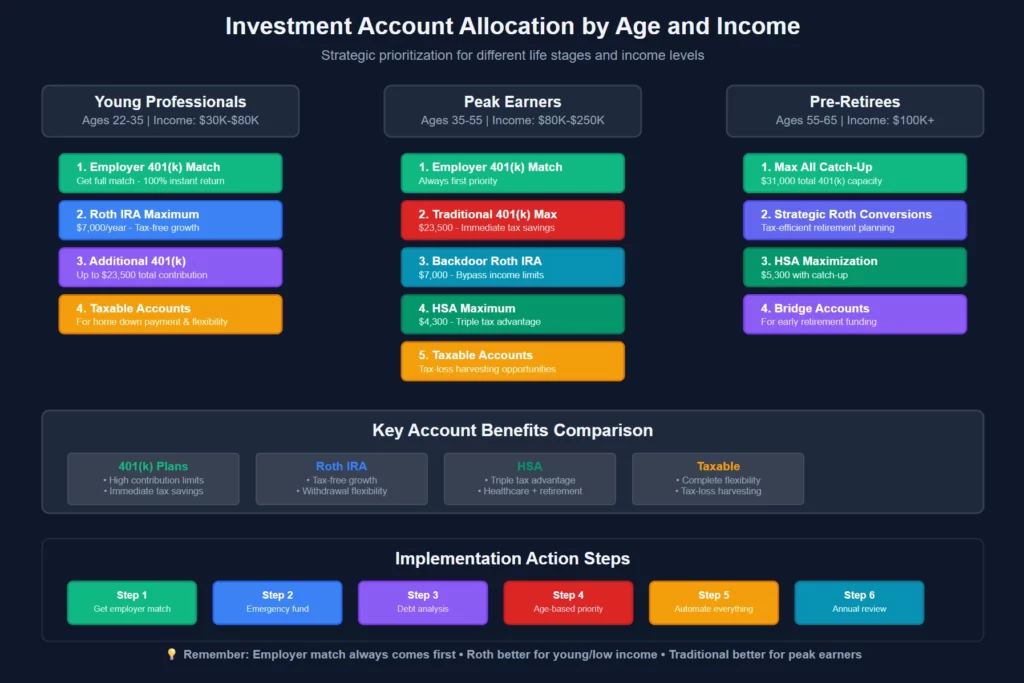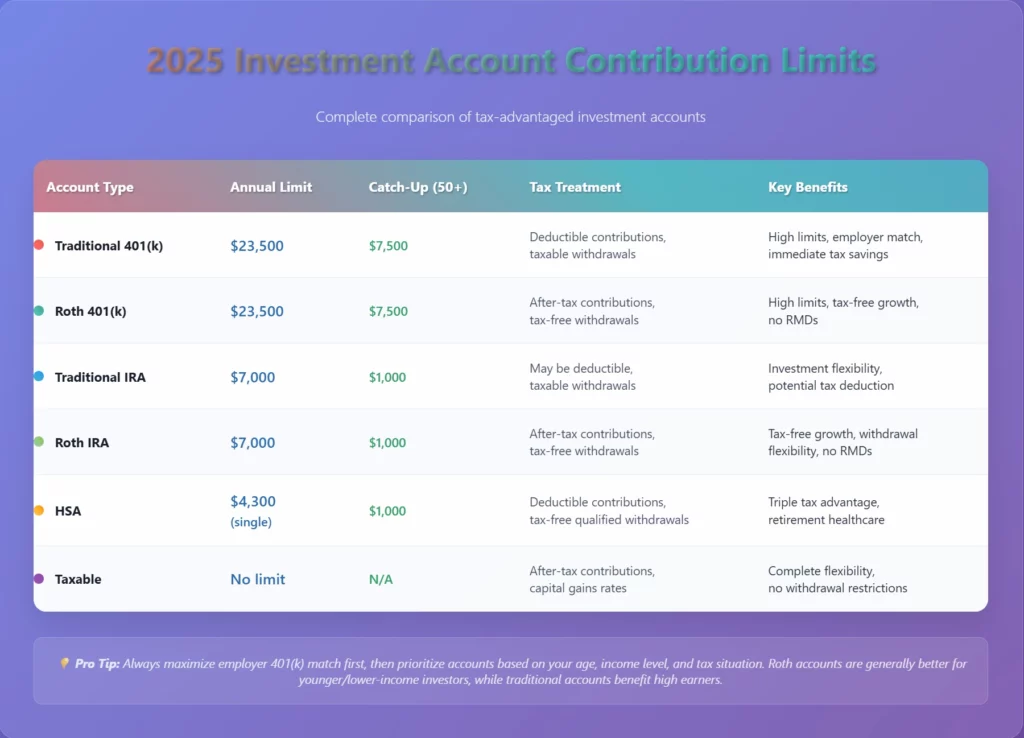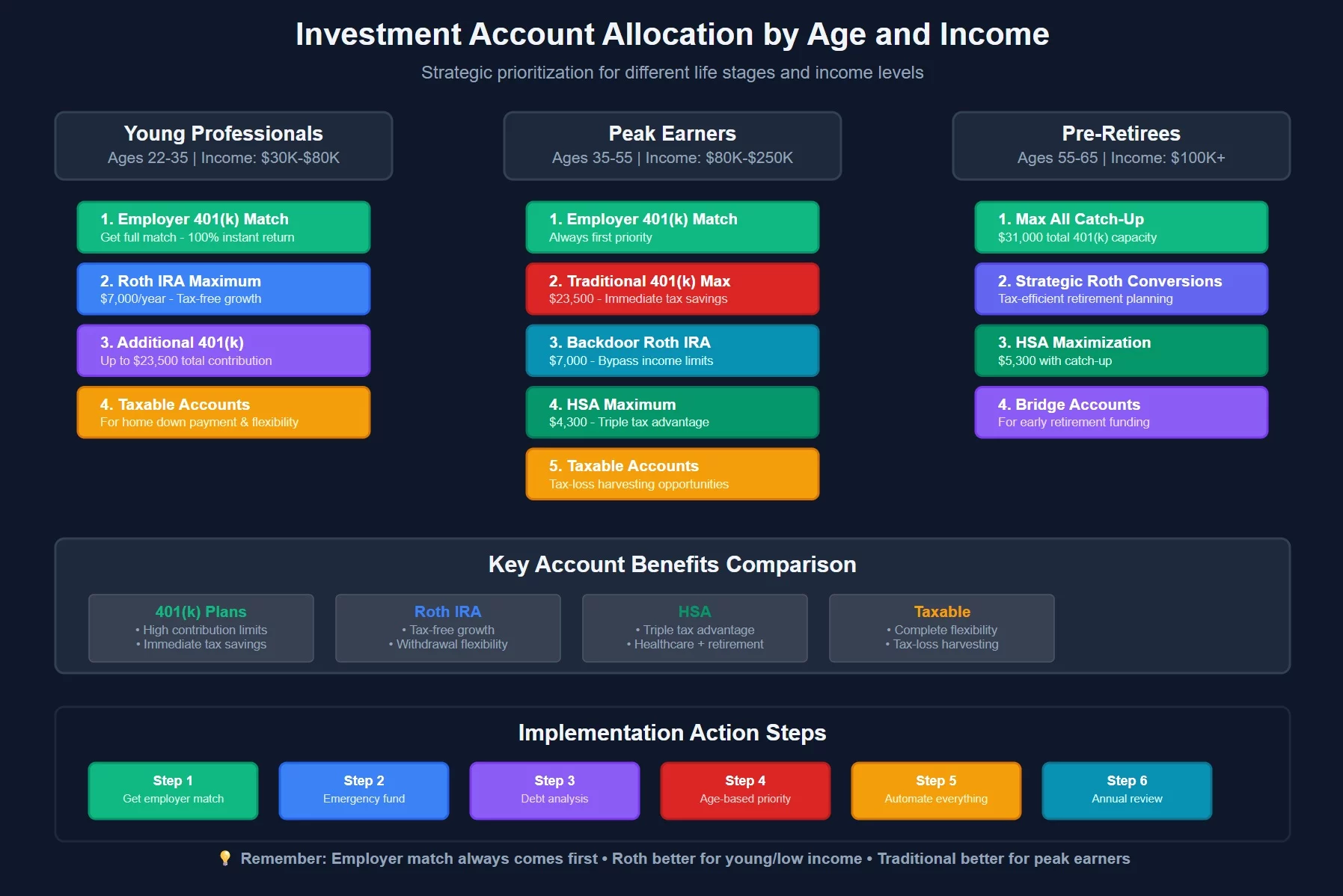I began trading in 2015 and started coaching in 2019. Investment account selection fundamentally determines your wealth-building success. However, most investors randomly choose accounts without strategic optimization. Therefore, this guide helps you maximize returns through systematic account prioritization and tax efficiency.
👉 In this guide, you will learn:
- 🏦 The optimal order for funding different investment accounts
- 🧾 Tax implications that dramatically impact long-term returns
- 💰 How to maximize employer benefits and contribution limits
- 📊 Account-specific investment strategies for optimal allocation
- 🎯 Age-based approaches to account prioritization
- ⚖️ When to break conventional rules for personal optimization
- 🚀 Advanced strategies for high earners and catch-up scenarios
Strategic account optimization can add hundreds of thousands to your retirement wealth. Unfortunately, most investors leave significant money on the table through poor account selection. Additionally, tax inefficiency compounds over decades, creating enormous opportunity costs.
Table of Contents
The Investment Account Hierarchy Framework 🎯
Not all investment accounts provide equal benefits. Therefore, systematic prioritization maximizes tax advantages and compound growth. Furthermore, this hierarchy adapts to different income levels and life circumstances.
The Universal Account Priority Order
Priority #1: Employer 401(k) Match Employer matching represents immediate 100% returns on investment. Moreover, missing matches means forfeiting free money permanently. Additionally, matching contributions vest immediately in most plans.
Employer match optimization strategies:
- 🏢 Contribute minimum required for full employer match always
- 🏢 Understand vesting schedules and job change implications
- 🏢 Consider Roth 401(k) options for tax diversification
- 🏢 Increase contributions automatically with salary raises
Priority #2: High-Interest Debt Elimination Debt above 6-7% interest rates typically justifies aggressive payoff before investing. However, always capture employer matches regardless of debt levels. Furthermore, guaranteed debt reduction often beats uncertain investment returns.
Priority #3: Emergency Fund Foundation Emergency funds prevent forced investment liquidations during financial crises. Moreover, 3-6 months of expenses in high-yield savings provides essential stability. Additionally, adequate emergency funds enable more aggressive investment strategies.
Priority #4: Roth IRA Maximization Roth IRAs offer unmatched flexibility and tax-free growth potential. Furthermore, contribution withdrawals remain available penalty-free for emergencies. Additionally, no required minimum distributions provide estate planning advantages.
Priority #5: Additional 401(k) Contributions After maximizing Roth IRA, additional 401(k) contributions provide valuable tax deferral. Moreover, higher contribution limits enable aggressive retirement savings. Additionally, automated payroll deductions ensure investment consistency.
Priority #6: HSA Contributions (If Available) Health Savings Accounts offer triple tax advantages: deductible contributions, tax-free growth, and tax-free qualified withdrawals. Furthermore, HSAs function as retirement accounts after age 65. Additionally, medical expenses in retirement provide ample withdrawal opportunities.
Priority #7: Taxable Investment Accounts Taxable accounts provide complete flexibility for multiple financial goals. Moreover, they enable tax-loss harvesting strategies. Additionally, they avoid withdrawal restrictions of retirement accounts.

Understanding Each Account Type 🏦
401(k) Plans: The Retirement Workhorse
Traditional 401(k) plans offer immediate tax deductions and tax-deferred growth. However, withdrawals in retirement face ordinary income taxation. Furthermore, required minimum distributions begin at age 73.
401(k) Advantages:
- 🧾 Immediate tax deduction reduces current tax burden
- 📈 Tax-deferred growth accelerates compound returns
- 🏢 Employer matching provides instant returns
- 💰 High contribution limits enable aggressive saving
401(k) Limitations:
- 🚫 Early withdrawal penalties before age 59½
- 🧾 Ordinary income tax on all withdrawals
- 📊 Required minimum distributions reduce flexibility
- 🎯 Limited investment options compared to IRAs
Optimal 401(k) Strategies:
- 📊 Contribute enough for full employer match immediately
- 💰 Use traditional 401(k) during peak earning years
- 🔄 Consider Roth 401(k) for tax diversification
- 📈 Maximize contributions during high-income periods
Roth IRA: The Flexibility Champion
Roth IRAs provide tax-free growth and withdrawals in retirement. Moreover, contributions can be withdrawn penalty-free anytime. Additionally, no required minimum distributions provide estate planning benefits.
Roth IRA Advantages:
- 🚀 Tax-free growth and qualified withdrawals
- 💰 Contribution withdrawals available penalty-free
- 🎯 No required minimum distributions ever
- 🏠 First-time homebuyer withdrawal exceptions
Roth IRA Limitations:
- 💸 No immediate tax deduction for contributions
- 📊 Income limits restrict high earner eligibility
- 💰 Lower contribution limits than 401(k) plans
- ⏰ Five-year rules for earnings withdrawals
Optimal Roth IRA Strategies:
- 🎯 Prioritize during lower-income years
- 🔄 Use backdoor conversions for high earners
- 💰 Invest in highest-growth potential assets
- 📈 Consider as emergency fund supplement
Taxable Accounts: The Ultimate Flexibility
Taxable investment accounts provide complete liquidity and flexibility. Furthermore, they enable tax-loss harvesting strategies. Additionally, qualified dividends and long-term capital gains receive preferential tax treatment.
Taxable Account Advantages:
- 🔓 Complete liquidity and withdrawal flexibility
- 📊 Tax-loss harvesting optimization opportunities
- 💰 Preferential capital gains tax rates
- 🎯 No contribution limits or restrictions
Taxable Account Limitations:
- 🧾 No tax deduction for contributions
- 📈 Dividends and capital gains create annual tax obligations
- 💸 Less tax-efficient than retirement accounts
- 📊 Requires more sophisticated tax management
Optimal Taxable Account Strategies:
- 🧾 Focus on tax-efficient index funds
- 📊 Implement systematic tax-loss harvesting
- 💰 Hold tax-inefficient investments in retirement accounts
- 🔄 Use for goals with uncertain timelines
Age-Based Account Optimization Strategies 📊
Investment account priorities evolve with age and life circumstances. Therefore, strategic adjustments maximize tax efficiency and wealth building. Furthermore, changing income levels require priority modifications.
Young Professionals (Ages 20-35)
Early career professionals typically face lower tax brackets and limited income. However, they possess maximum time for compound growth. Additionally, Roth account benefits often outweigh immediate tax deductions.
Young Professional Priority Order:
- 💰 Employer 401(k) match
- 🚀 Roth IRA maximization
- 📊 Additional 401(k) contributions
- 💡 Taxable accounts for near-term goals
Strategic Considerations for Young Professionals:
- 🎯 Emphasize Roth accounts for tax-free growth
- 📈 Maintain aggressive growth allocations
- 💰 Build emergency fund alongside investing
- 🏠 Use taxable accounts for home down payment
Peak Earners (Ages 35-55)
High-income professionals benefit most from immediate tax deductions. Furthermore, they can maximize all available contribution limits. Additionally, catch-up contributions become available after age 50.
Peak Earner Priority Order:
- 💰 Employer 401(k) match
- 📊 Traditional 401(k) maximization
- 🔄 Backdoor Roth IRA conversions
- 🏥 HSA maximization (if available)
- 💡 Taxable accounts for flexibility
Strategic Considerations for Peak Earners:
- 🧾 Prioritize immediate tax deductions
- 💰 Implement backdoor Roth strategies
- 📊 Consider tax-loss harvesting in taxable accounts
- 🎯 Use catch-up contributions after age 50
Pre-Retirees (Ages 55-65)
Pre-retirement requires balancing growth with stability. Moreover, this period offers final opportunities for aggressive savings. Additionally, strategic Roth conversions can optimize tax situations.
Pre-Retiree Priority Order:
- 💰 Maximize all catch-up contributions
- 🔄 Strategic Roth conversion opportunities
- 📊 Bridge account building for early retirement
- 🏥 HSA maximization for healthcare costs
Advanced Account Optimization Strategies 🚀
Sophisticated investors can implement advanced strategies that maximize tax efficiency. However, these approaches require careful planning and ongoing management. Furthermore, they often work best for high-income individuals.
Asset Location Optimization
Different investments belong in different account types for tax efficiency. Therefore, strategic asset location can improve after-tax returns significantly. Furthermore, this strategy becomes more valuable as portfolios grow.
Asset Location Guidelines:
Tax-Advantaged Accounts (401k, Traditional IRA):
- 🏦 Bonds and fixed income investments
- 🏠 REITs and real estate investments
- 📊 High-turnover actively managed funds
- 💰 International stocks for foreign tax credit benefits
Roth Accounts:
- 🚀 Highest growth potential investments
- 💎 Small-cap and emerging market stocks
- 📈 Individual growth stocks
- 🔬 Technology and biotech investments
Taxable Accounts:
- 📊 Broad market index funds
- 💰 Tax-managed funds
- 🧾 Municipal bonds (for high earners)
- 🔄 Investments for tax-loss harvesting
Tax-Loss Harvesting Strategies
Systematic tax-loss harvesting can generate significant annual tax savings. However, wash sale rules require careful management. Furthermore, this strategy works best in taxable accounts with diversified holdings.
Tax-Loss Harvesting Implementation:
- 📊 Harvest losses systematically throughout the year
- 🔄 Avoid wash sale violations through substitute securities
- 💰 Use losses to offset capital gains and ordinary income
- 📈 Reinvest proceeds in similar but not identical investments
Mega Backdoor Roth Strategy
High earners with access to after-tax 401(k) contributions can implement mega backdoor Roth conversions. This strategy enables Roth contributions far exceeding normal limits. However, it requires specific plan features and careful execution.
Mega Backdoor Roth Requirements:
- 🏢 Employer plan allows after-tax contributions
- 🔄 Plan permits in-service withdrawals or conversions
- 💰 Already maximizing traditional 401(k) contributions
- 📊 Understanding of pro-rata rule implications
Account Optimization Decision Framework 🎯
Creating your personalized account strategy requires systematic evaluation of multiple factors.
Therefore, use this framework to determine optimal prioritization. Furthermore, reassess annually as circumstances change.
Income Level Analysis
Low to Moderate Income (Under $60,000):
- 🎯 Prioritize Roth accounts for tax-free growth
- 💰 Focus on employer matches first
- 📊 Build emergency fund alongside investing
- 🏠 Use taxable accounts for near-term goals
High Income ($60,000-$200,000):
- ⚖️ Balance traditional and Roth contributions
- 🧾 Consider immediate tax deduction benefits
- 💰 Maximize all available retirement contributions
- 📊 Implement tax-loss harvesting strategies
Very High Income (Over $200,000):
- 🏦 Prioritize traditional 401(k) for tax deferral
- 🔄 Implement backdoor Roth strategies
- 🏥 Maximize HSA contributions if available
- 💰 Consider advanced tax strategies
Age and Timeline Considerations
Long Timeline (20+ years to retirement):
- 🚀 Emphasize growth-oriented accounts
- 📈 Maintain aggressive asset allocations
- 💰 Prioritize Roth accounts for younger investors
- 🎯 Focus on maximizing compound growth

Medium Timeline (10-20 years to retirement):
- ⚖️ Balance growth with stability
- 📊 Begin modest shift toward conservative assets
- 💰 Maximize catch-up contributions if available
- 🔄 Consider strategic Roth conversions
Short Timeline (Under 10 years to retirement):
- 🎯 Focus on wealth preservation strategies
- 📊 Increase conservative asset allocation
- 💰 Build bridge accounts for early retirement
- 🏥 Prepare for healthcare cost planning
Table: 2025 Contribution Limits and Account Comparison

Common Account Optimization Mistakes 🚨
Understanding typical mistakes helps investors avoid costly errors. Furthermore, these mistakes can reduce retirement wealth significantly. Therefore, awareness and prevention prove crucial for success.
Mistake #1: Ignoring Employer Matches
Many employees fail to maximize employer matching contributions. However, this represents forfeiting immediate 100% returns. Moreover, compound growth on missed matches creates enormous opportunity costs over decades.
Mistake #2: Wrong Account Type for Income Level
High earners often prioritize Roth contributions when traditional accounts provide better benefits. Conversely, low earners may choose traditional accounts when Roth provides superior long-term value.
Mistake #3: Poor Asset Location Decisions
Placing tax-inefficient investments in taxable accounts reduces after-tax returns. Furthermore, keeping bonds in Roth accounts wastes tax-free growth potential. Additionally, ignoring asset location can cost thousands annually.
Mistake #4: Neglecting Tax-Loss Harvesting
Investors often ignore systematic tax-loss harvesting opportunities. However, this strategy can generate significant annual tax savings. Moreover, accumulated tax savings can be reinvested for additional compound growth.
Mistake #5: Inadequate Account Diversification
Concentrating investments in single account types reduces flexibility. Furthermore, tax diversification provides options during retirement. Additionally, different accounts serve different purposes optimally.
Video Recommendation 🎥
🎬 For comprehensive guidance on investment account optimization, watch my Successful Tradings video about maximizing tax efficiency across all account types. The video demonstrates practical strategies for different income levels and ages. Moreover, it shows real examples of optimal account allocation.
Watch it here: https://www.youtube.com/@SuccessfulTradings and search for “Investment Account Optimization Strategy.”
You will learn specific techniques that can add hundreds of thousands to your retirement wealth through better account selection.
FAQs 🤔
Q: Should I contribute to traditional or Roth 401(k)? A: Generally choose traditional during peak earning years for immediate tax savings, and Roth during lower-income periods. Consider splitting contributions for tax diversification.
Q: Can I contribute to both 401(k) and IRA? A: Yes, but IRA deductibility phases out at higher incomes with workplace plans. Focus on 401(k) maximization first, then Roth IRA for additional savings.
Q: How much should I keep in taxable accounts? A: After maximizing tax-advantaged accounts, use taxable accounts for emergency funds beyond 6 months and goals within 5-10 years. No upper limit exists.
Q: What’s the backdoor Roth strategy? A: High earners can contribute to traditional IRA (non-deductible) then convert to Roth IRA. This bypasses income limits but requires careful execution to avoid tax complications.
Q: Should I max out 401(k) before Roth IRA? A: Contribute enough for employer match first, then typically max Roth IRA before additional 401(k) contributions due to better investment options and flexibility.
Q: How do catch-up contributions work? A: After age 50, you can contribute additional amounts beyond normal limits. For 2025: $7,500 extra to 401(k), $1,000 extra to IRA, $1,000 extra to HSA.
Q: When should I use taxable accounts over retirement accounts? A: Use taxable accounts when you’ve maximized retirement account contributions, need liquidity within 5 years, or want complete investment flexibility.
Q: How important is asset location optimization? A: Very important for larger portfolios. Proper asset location can improve after-tax returns by 0.25-0.75% annually, compounding to significant wealth differences over time.
Conclusion
Investment account optimization represents one of the most powerful wealth-building strategies available. Therefore, systematic account prioritization can add hundreds of thousands to your retirement wealth. Furthermore, starting early amplifies these benefits through decades of compound growth.
Success requires understanding each account type’s unique benefits and limitations. Additionally, optimal strategies evolve with age, income, and life circumstances requiring periodic reassessment.
Finally, avoiding common mistakes while implementing advanced strategies when appropriate maximizes your financial future. Remember that perfect optimization matters less than consistent progress across all account types.

Hold a Master Degree in Electrical engineering from Texas A&M University.
African born – French Raised and US matured who speak 5 languages.
Active Stock Options Trader and Coach since 2014.
Most Swing Trade weekly Options and Specialize in 10-Baggers !
YouTube Channel: https://www.youtube.com/c/SuccessfulTradings
Other Website: https://237answersblog.com/
